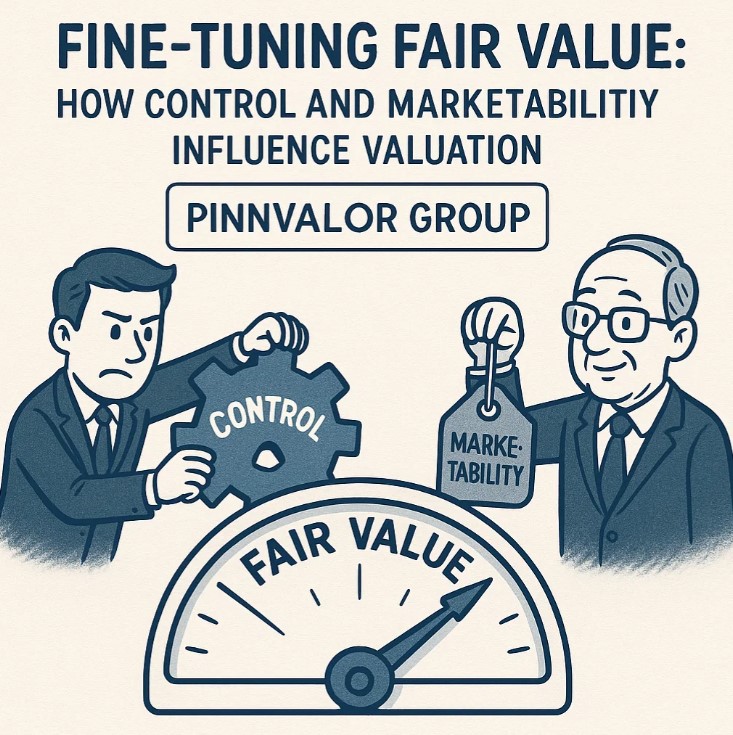
In the nuanced world of business valuation, fair value is rarely a simple number. It’s a carefully calibrated figure, shaped not only by financial fundamentals but also by critical qualitative factors—such as control and marketability. Two important valuation adjustments—Discount for Lack of Control (DLOC) and Discount for Lack of Marketability (DLOM)—play a pivotal role in arriving at a realistic, defendable valuation for privately held businesses or illiquid interests.
What happens to a company’s value when you can’t control it—or easily sell it?
An investor won’t pay full price for a seat without influence. Lack of control is a discount, not a defect—just a reality check.
Let’s dive into how these discounts are applied, why they matter, and what they reveal about a business’s true worth.
🔍 What Are DLOC and DLOM?
Discount for Lack of Control (DLOC)
A Discount for Lack of Control is applied when the ownership interest being valued does not have the authority to make key operational, strategic, or financial decisions. Minority shareholders often lack:
- Voting power over major decisions
- Influence over dividend policies
- Control over hiring/firing executives
- Say in company direction or sale
Why it matters: An investor will typically pay less for a non-controlling interest, simply because it lacks influence over the entity’s future. This reduction in value is what the DLOC accounts for.
Discount for Lack of Marketability (DLOM)
The Discount for Lack of Marketability reflects the reduced value of an asset that cannot be easily sold or converted into cash. Unlike publicly traded stocks, private business interests don’t have a ready market or liquidity.
Key reasons DLOM applies:
- Shares are not listed on an exchange
- Sales are often restricted by shareholder agreements
- Longer holding periods are typical
- Exit strategies may be uncertain or time-consuming
Why it matters: Investors demand compensation for illiquidity—reflected in the form of a discount on value.
📊 When Are These Discounts Applied?
These discounts are typically relevant when valuing:
- Private companies
- Partial interests in businesses
- Family-owned enterprises
- Equity shares being transferred under legal, tax, or estate planning contexts
⚖️ Quantifying the Discounts: How Much?
There’s no one-size-fits-all percentage—each discount depends on the specific facts of the case. However, typical market benchmarks are:
- DLOC: Ranges from 10% to 40%, depending on the degree of minority status and control limitations.
- DLOM: Generally between 20% to 50%, depending on factors such as restrictions on sale, company size, profitability, and historical sale data.
Valuers may use empirical studies, such as:
- Restricted Stock Studies
- Pre-IPO Studies
- Merger & Acquisition Data
- Control premium analysis (to back-calculate DLOC)

🧠 Why Are These Discounts Often Misunderstood?
Many stakeholders struggle with the concept that a business worth ₹100 crore on a control, marketable basis might be worth only ₹60–70 crore when sold as a non-controlling, illiquid interest. Here's why it gets complex:
- Overlap confusion: DLOC and DLOM are separate and additive, but not simply summative.
- Lack of standardization: No fixed formula exists—judgment plays a large role.
- Legal scrutiny: Courts and tax authorities often challenge excessive or unsupported discount rates.
💼 Real-World Example
Imagine a business valued at ₹50 crore on a 100% control, marketable basis. A 30% DLOC and a 25% DLOM are applied to a 20% minority interest:
- DLOC-adjusted value: ₹50 crore × (1 - 30%) = ₹35 crore
- DLOM-adjusted value: ₹35 crore × (1 - 25%) = ₹26.25 crore
Thus, the effective discount is 47.5%, not a simple 55%. This highlights the importance of sequencing and compounding effects in valuation.
🔐 Final Thoughts: Precision Is Power
DLOC and DLOM are essential tools for sharpening the accuracy of a valuation. They ensure that the value reflects not just what a business is worth on paper, but also what it’s worth in practice—especially when control and liquidity are absent.
For business owners, investors, and advisors alike, understanding these discounts is critical to negotiating deals, structuring transactions, and managing stakeholder expectations.
📣 Quote-Worthy Takeaways:
#True value lies not just in the business—but in who controls it and how quickly it can be sold.
#DLOC and DLOM are not deductions—they’re reflections of economic reality.
